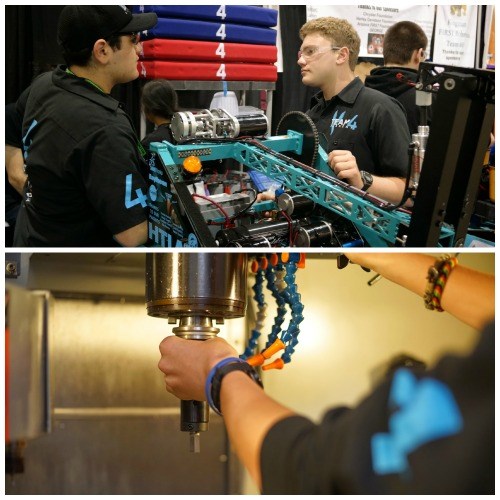What’s Rotary Broaching, and How Did It Help a Robotics Team?
Rotary broaching enables CNC machines to create internal and external shapes such as squares, hexes and serrations. Slater Tool contributed its broaching technology to help a Los Angeles charter school program more effectively create components for a competition robot.
Share








Many external and internal shapes can be created via rotary broaching, as demonstrated in this “rotary broaching 101” video from Slater Tools, a designer and manufacturer of rotary broaching tools. A fast and efficient machining method, rotary broaching is used for making squares, hexes, serrations, keyways and a range of many other shapes into or onto a workpiece using any CNC lathe, mill or Swiss-type.
Recently, Slater Tools’ rotary broaching technology proved particularly helpful to High Tech Los Angeles (HTLA), a small, college-prep public charter school located in Southern California. Ranked as the state’s leading charter, HTLA uses technology to teach and inspire students. One way it accomplishes this is through after-school clubs such as the Robotics Team. This club teaches students the design and construction of robots, requiring teamwork and intellectual problem-solving skills. Students effectively operate a mini-corporation, running functional departments across multiple disciplines, including project management, design, machining and manufacturing, electronics, programming, business and finance, safety, logistics and media.
The HTLA Robotics Team, called Team4Element, participates in FIRST Robotics Competitions (For Inspiration and Recognition of Science and Technology). Under strict rules, limited resources and time limits, teams of students are challenged to raise funds, design a team “brand,” hone teamwork skills, and build and program robots to perform prescribed tasks against a field of competitors.
One of the biggest challenges HTLA Team4Element faced was in machining parts critical to the function and operation of their robot. Parts produced included drive wheels, gears, rotating components, sprockets and arms. The previous machining method was to hand broach parts using an arbor press, which was a very long and difficult process. That prompted Guy Chriqui, the team’s lead mentor, to reach out to Slater Tools for assistance.
When asked to assist in the robot building application for HTLA, the team at Slater Tools knew rotary broaching was the perfect answer to solve the students’ manufacturing problems. Unlike conventional hand broaching, in which a series of stepped polygon forms are pushed through a hole until the desired size and form is achieved, the rotary broach cuts the full form rapidly, one corner at a time.
With the tooling and guidance provided by Slater Tools, HTLA was able to successfully machine the parts it needed for its robot. Using a Haas VF2 VMC, they machined 30 to 40 parts with a ½-inch hex ID using a single Slater rotary broach and a 3700-1 tool holder. Parts were made in a single pass, maintaining good forms and precise tolerances. Given the significant stress placed on the actual components during use, students had to factor into their design the various moving parts, torque requirements, along with the need for tight fittings and secure connections.
The result of HTLA Team4Element’s efforts and collaboration with Slater Tools was a great success. HTLA produced a robot that was 2 × 3 × 5 feet and 150 lbs. Competing in a 50 × 30-foot playing field, the robot traveled at speeds of 6 to 19 fps, picked up and hurled a 2-foot-diameter exercise ball, scored points for passing and getting the ball into the goal. The robot even ran a “pick and roll” maneuver. It met the requirement of running for two minutes controlled by the students, and 15 seconds autonomously. HTLA took fifth place out of 50 teams.
Related Content
Using the Toolchanger to Automate Production
Taking advantage of a feature that’s already on the machine tool, Lang’s Haubex system uses the toolchanger to move and store parts, making it an easy-to-use and cost-effective automation solution.
Read MoreInvesting in Automation, Five-Axis to Increase Production Capacity
To meet an increase in demand, this shop invested heavily in automation solutions and five-axis machines to ramp up its production capabilities.
Read MoreCutting Part Programming Times Through AI
CAM Assist cuts repetition from part programming — early users say it cuts tribal knowledge and could be a useful tool for training new programmers.
Read MoreManaging Coolant with Skimmers, Refractometers and More
Bacteria-infected coolant harms machines and sickens machinists. Coolant management technologies like skimmers and automated systems counter this tendency.
Read MoreRead Next
Building Out a Foundation for Student Machinists
Autodesk and Haas have teamed up to produce an introductory course for students that covers the basics of CAD, CAM and CNC while providing them with a portfolio part.
Read MoreRegistration Now Open for the Precision Machining Technology Show (PMTS) 2025
The precision machining industry’s premier event returns to Cleveland, OH, April 1-3.
Read More5 Rules of Thumb for Buying CNC Machine Tools
Use these tips to carefully plan your machine tool purchases and to avoid regretting your decision later.
Read More

































.jpg;maxWidth=300;quality=90)
















